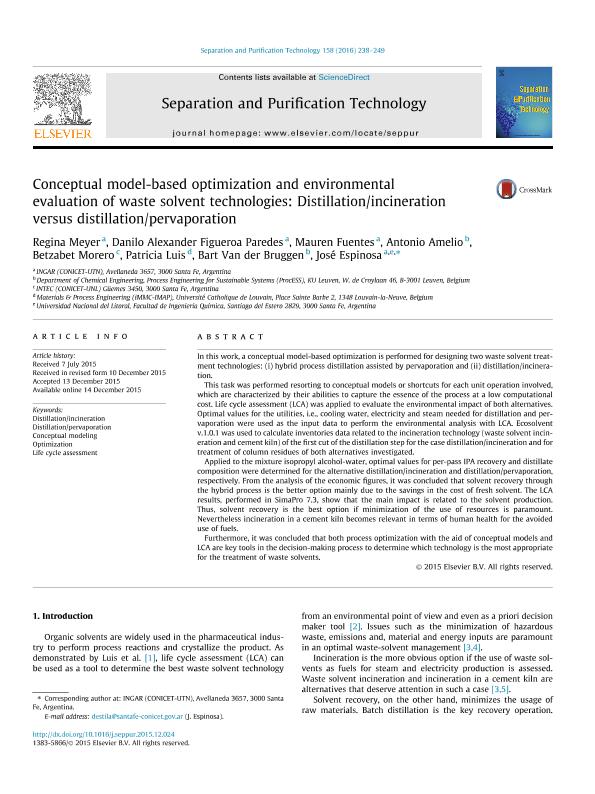Mostrar el registro sencillo del ítem
dc.contributor.author
Meyer, Regina Noemí

dc.contributor.author
Figueroa Paredes, Danilo Alexander

dc.contributor.author
Fuentes, Mauren
dc.contributor.author
Amelio, Antonio
dc.contributor.author
Morero, Betzabet del Valle

dc.contributor.author
Luis, Patricia
dc.contributor.author
Van Der Bruggen, Bart
dc.contributor.author
Espinosa, José
dc.date.available
2017-06-28T20:35:08Z
dc.date.issued
2015-12-14
dc.identifier.citation
Meyer, Regina Noemí; Figueroa Paredes, Danilo Alexander; Fuentes, Mauren; Amelio, Antonio; Morero, Betzabet del Valle; et al.; Conceptual Model-Based Optimization and Environmental Evaluation of Waste Solvent Technologies: Distillation/Incineration versus Distillation/Pervaporation; Elsevier Science; Separation and Purification Technology; 158; 14-12-2015; 238-249
dc.identifier.issn
1383-5866
dc.identifier.uri
http://hdl.handle.net/11336/19065
dc.description.abstract
In this work, a conceptual model-based optimization is performed for designing two waste solvent treatment technologies: i) hybrid process distillation assisted by pervaporation and ii) distillation/incineration.This task was performed resorting to conceptual models or shortcuts for each unit operation involved, which are characterized by their abilities to capture the essence of the process at a low computational cost. Life cycle assessment (LCA) was applied to evaluate the environmental impact of both alternatives. Optimal values for the utilities, i.e., cooling water, electricity and steam needed for distillation and pervaporation were used as the input data to perform the environmental analysis with LCA. Ecosolvent v.1.0.1 was used to calculate inventories data related to the incineration technology (waste solvent incineration and cement kiln) of the first cut of the distillation step for the case distillation/incineration and for treatment of column residues of both alternatives investigated.Applied to the mixture isopropyl alcohol-water, optimal values for per-pass IPA recovery and distillate composition were determined for the alternative distillation/incineration and distillation/pervaporation, respectively. From the analysis of the economic figures, it was concluded that solvent recovery through the hybrid process is the better option mainly due to the savings in the cost of fresh solvent. The LCA results, performed in SimaPro 7.3, show that the main impact is related to the solvent production. Thus, solvent recovery is the best option if minimization of the use of resources is paramount. Nevertheless incineration in a cement kiln becomes relevant in terms of human health for the avoided use of fuels.Furthermore, it was concluded that both process optimization with the aid of conceptual models and LCA are key tools in the decision-making process to determine which technology is the most appropriate for the treatment of waste solvents.
dc.format
application/pdf
dc.language.iso
eng
dc.publisher
Elsevier Science

dc.rights
info:eu-repo/semantics/openAccess
dc.rights.uri
https://creativecommons.org/licenses/by-nc-nd/2.5/ar/
dc.subject
Distillation / Incineration
dc.subject
Distillation / Pervaporation
dc.subject
Conceptual Modeling
dc.subject
Optimization
dc.subject.classification
Ingeniería de Procesos Químicos

dc.subject.classification
Ingeniería Química

dc.subject.classification
INGENIERÍAS Y TECNOLOGÍAS

dc.title
Conceptual Model-Based Optimization and Environmental Evaluation of Waste Solvent Technologies: Distillation/Incineration versus Distillation/Pervaporation
dc.type
info:eu-repo/semantics/article
dc.type
info:ar-repo/semantics/artículo
dc.type
info:eu-repo/semantics/publishedVersion
dc.date.updated
2016-08-01T18:38:08Z
dc.journal.volume
158
dc.journal.pagination
238-249
dc.journal.pais
Países Bajos

dc.journal.ciudad
Amsterdam
dc.description.fil
Fil: Meyer, Regina Noemí. Consejo Nacional de Investigaciones Científicas y Técnicas. Centro Científico Tecnológico Conicet - Santa Fe. Instituto de Desarrollo y Diseño. Universidad Tecnológica Nacional. Facultad Regional Santa Fe. Instituto de Desarrollo y Diseño; Argentina
dc.description.fil
Fil: Figueroa Paredes, Danilo Alexander. Consejo Nacional de Investigaciones Científicas y Técnicas. Centro Científico Tecnológico Conicet - Santa Fe. Instituto de Desarrollo y Diseño. Universidad Tecnológica Nacional. Facultad Regional Santa Fe. Instituto de Desarrollo y Diseño; Argentina
dc.description.fil
Fil: Fuentes, Mauren. Consejo Nacional de Investigaciones Científicas y Técnicas. Centro Científico Tecnológico Conicet - Santa Fe. Instituto de Desarrollo y Diseño. Universidad Tecnológica Nacional. Facultad Regional Santa Fe. Instituto de Desarrollo y Diseño; Argentina
dc.description.fil
Fil: Amelio, Antonio. Universite Catholique de Louvain; Bélgica
dc.description.fil
Fil: Morero, Betzabet del Valle. Consejo Nacional de Investigaciones Científicas y Técnicas. Centro Científico Tecnológico Conicet - Santa Fe. Instituto de Desarrollo Tecnológico para la Industria Química. Universidad Nacional del Litoral. Instituto de Desarrollo Tecnológico para la Industria Química; Argentina
dc.description.fil
Fil: Luis, Patricia. Universite Catholique de Louvain; Bélgica
dc.description.fil
Fil: Van Der Bruggen, Bart. Universite Catholique de Louvain; Bélgica
dc.description.fil
Fil: Espinosa, José. Consejo Nacional de Investigaciones Científicas y Técnicas. Centro Científico Tecnológico Conicet - Santa Fe. Instituto de Desarrollo y Diseño. Universidad Tecnológica Nacional. Facultad Regional Santa Fe. Instituto de Desarrollo y Diseño; Argentina. Universidad Nacional del Litoral; Argentina
dc.journal.title
Separation and Purification Technology

dc.relation.alternativeid
info:eu-repo/semantics/altIdentifier/doi/http://dx.doi.org/10.1016/j.seppur.2015.12.024
dc.relation.alternativeid
info:eu-repo/semantics/altIdentifier/url/http://www.sciencedirect.com/science/article/pii/S1383586615303932?via%3Dihub
Archivos asociados
